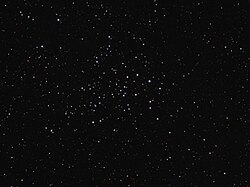
KNOWPIA
WELCOME TO KNOWPIA
Summary
NGC 1528 is an open cluster in the constellation Perseus. It was discovered by William Herschel in 1790. It is located in the north-eastern part of the constellation, just under 3 degrees north of μ Persei. Less than 1.5° to the southeast is the open cluster NGC 1545 (m = 6.2). The NGC 1528 is clearly visible with 10x50 binoculars. 165 stars are recognised as members of NGC 1528, the brightest of which has apparent magnitude 8.7.[4]
| NGC 1528 | |
|---|---|
 NGC 1528 Open Cluster | |
| Observation data (J2000 epoch) | |
| Right ascension | 04h 15m 30.72s[1] |
| Declination | +51° 13′ 04.8″[1] |
| Distance | 3,110 ± 500 ly (954 ± 154 pc)[2] |
| Apparent magnitude (V) | 6.4[3] |
| Apparent dimensions (V) | 23' |
| Physical characteristics | |
| Estimated age | 110 Ma[2] |
| Other designations | Cr 47 |
| Associations | |
| Constellation | Perseus |
See also edit
References edit
- ^ a b Cantat-Gaudin, T.; Anders, F. (January 2020). "Clusters and mirages: cataloguing stellar aggregates in the Milky Way". Astronomy & Astrophysics. 633: 22. arXiv:1911.07075. Bibcode:2020A&A...633A..99C. doi:10.1051/0004-6361/201936691. S2CID 208138247. A99.
- ^ a b Peña, J. H.; et al. (October 2019). "Study of the Open Cluster NGC 1528 Through uvby - β Photoelectric Photometry". Revista Mexicana de Astronomía y Astrofísica. 55: 203–209. Bibcode:2019RMxAA..55..203P. doi:10.22201/ia.01851101p.2019.55.02.08.
- ^ "NGC 1528". SIMBAD. Centre de données astronomiques de Strasbourg. Retrieved 2021-12-15.
- ^ Stephen James O'Meara (2007). Deep-Sky Companions: Hidden Treasures. Cambridge University Press. pp. 131–132. ISBN 9781139463737.
External links edit
- Media related to NGC 1528 at Wikimedia Commons
- NGC 1528 on WikiSky: DSS2, SDSS, GALEX, IRAS, Hydrogen α, X-Ray, Astrophoto, Sky Map, Articles and images
- SEDS


